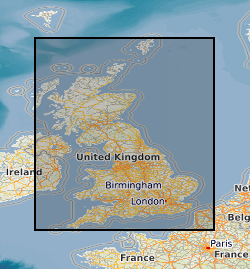Radon potential for Great Britain version 3
Radon is a natural radioactive gas, which enters buildings from the ground. The joint UK Health Security Agency (UKHSA) (formerly Public Health England (PHE)) - British Geological Survey (BGS) digital dataset Radon Potential for Great Britain provides the current definitive map of radon Affected Areas in Great Britain. Exposure to high concentrations increases the risk of lung cancer. UK Health Security Agency (formerly PHE) recommends that radon levels should be reduced in homes where the annual average is at or above 200 becquerels per cubic metre (200 Bq m-3). This is termed the Action Level. The UKHSA defines radon Affected Areas as those with 1% chance or more of a house having a radon concentration at or above the Action Level of 200 Bq m-3. The dataset allows an estimate to be made of the probability that an individual property is at or above the Action Level for radon. This information provides an answer to one of the standard legal enquiries on house purchase in England and Wales, known as CON29 standard Enquiry of Local Authority; 3.13 Radon Gas: Location of the Property in a Radon Affected Area. Radon Potential for Great Britain also provides information on the level of protection required for new buildings as described in the latest Building Research Establishment guidance on radon protective measures for new buildings (Radon: guidance on protective measures for new dwellings; BR 211, 2015 in Scotland, England, Wales and Northern Ireland). This radon potential hazard information for Great Britain is based on UKHSA indoor radon measurements and BGS digital geology information. This product was derived from BGS Geology 50k (formerly known as DigMap50k) version 8 and UKHSA in-house radon measurement data. The indoor radon data is used with the agreement of the UKHSA. Confidentiality of measurement locations is maintained through data management practices. Access to the data is under licence.

dataset
:
http://data.bgs.ac.uk/id/dataHolding/13607974
English
Geoscientific information
GEMET - INSPIRE themes, version 1.0:
BGS Thesaurus of Geosciences:
Geochemistry
UK Location (INSPIRE)
Radon protection
Radon potential
Natural hazards
Free:
Free:
NERC_DDC
-7.4829,
49.8165,
2.6955,
60.7850
GBN, GREAT BRITAIN [id=139600]
creation: 2021-07-01
unknown
-
2021-07
vector
British Geological Survey
Enquiries
Environmental Science Centre, Nicker Hill, Keyworth,
NOTTINGHAM,
NG12 5GG,
United Kingdom
tel: 0115 936 3143
email:
enquiries@bgs.ac.uk
Role: distributor
British Geological Survey
Enquiries
Environmental Science Centre, Nicker Hill, Keyworth,
NOTTINGHAM,
NG12 5GG,
United Kingdom
tel: 0115 936 3143
email:
enquiries@bgs.ac.uk
Role: point of contact
British Geological Survey
Enquiries
email:
not available
Role: distributor
British Geological Survey
Enquiries
email:
not available
Role: point of contact
Data Quality
The radon potential dataset is derived by combining a simplified version of the geology of Great Britain (BGS Geology 50 version 8) with indoor radon measurement data collected by UK Health Security Agency (previously Public Health England (PHE). The land area is first divided up into simplified geologies, a combination of bedrock and superficial geological characteristics, derived from BGS GeologyGB-50 (1: 50 000 scale) digital geological map data. A code bedrock/superficial (BS) code is assigned to each of them. Each different simplified geology may appear at the land surface in many discontinuous locations across the country. Each simplified geology is then divided in 1 Km squares by using the OS British National Grid. From this division results a list of spatially referenced KMBS (a simplification of 1 Km2 / BS) polygons containing information about both the simplified geology and the BNG 1km square. UK Health Security Agency has a database of houses in which long-term (3 to 6 months) measurements of radon concentration have been made, and whose locations are accurately known. Each of these measurements is allocated to the underlying geological polygon followed by actual measurements' coordinates stripping off. This procedure allows for anonymization of house data. Taking each simplified geology in turn, the spatial variation of radon potential is mapped, treating the geology as if it were continuous over the land area. Bedrock, stratigraphic (order in which rock layers are laid down) or lithological (rock characteristics) generalisations of the simplified geologies may be required to assure that the number of radon measurements is enough to estimation the radon potential. All of the maps of radon potential within different simplified geologies are then combined to produce a map of variation in radon potential over the whole land surface. This dataset formed the raw data on which processing was carried out to ensure all end-users would achieve consistent results. All data processing was carried out using ESRI ArcGIS 10.7 software.
INSPIRE Implementing rules laying down technical arrangements for the interoperability and harmonisation of Geology
Commission Regulation (EU) No 1089/2010 of 23 November 2010 implementing Directive 2007/2/EC of the European Parliament and of the Council as regards interoperability of spatial data sets and services
Constraints
The copyright of materials derived from the British Geological Survey's work is vested in the Natural Environment Research Council [NERC]. No part of this work may be reproduced or transmitted in any form or by any means, or stored in a retrieval system of any nature, without the prior permission of the copyright holder, via the BGS Intellectual Property Rights Manager. Use by customers of information provided by the BGS, is at the customer's own risk. In view of the disparate sources of information at BGS's disposal, including such material donated to BGS, that BGS accepts in good faith as being accurate, the Natural Environment Research Council (NERC) gives no warranty, expressed or implied, as to the quality or accuracy of the information supplied, or to the information's suitability for any use. NERC/BGS accepts no liability whatever in respect of loss, damage, injury or other occurence however caused.
The dataset is made available to external clients under BGS Digital Data Licence terms and conditions. Revert to the IPR Section (iprdigital@bgs.ac.uk) if further advice is required with regard to permitted usage.
Metadata about metadata
e943ecb2-c82e-240b-e053-0937940ac5ca
British Geological Survey
Environmental Science Centre,Keyworth,
NOTTINGHAM,
NG12 5GG,
United Kingdom
tel: +44 115 936 3100
email:
enquiries@bgs.ac.uk
Role: point of contact
2024-04-24
